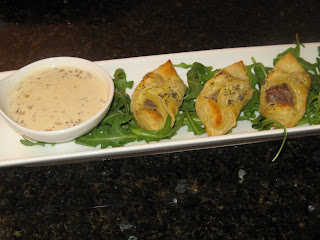 Everyone has one of those foods for which they have no off-switch. For me, it's pancakes. I can just keep going. As a result, I don't have them too often. But Shrove Tuesday is only a few days away and I smell an excuse to eat pancakes for dinner. Yay!
Everyone has one of those foods for which they have no off-switch. For me, it's pancakes. I can just keep going. As a result, I don't have them too often. But Shrove Tuesday is only a few days away and I smell an excuse to eat pancakes for dinner. Yay!There are a million variations on pancakes nowadays. There are all the standard versions -- blueberry, banana, chocolate chip -- and the healthy ones -- whole wheat, buckwheat, multigrain. Most fun are the unexpected interpretations. I just phoned my sister-in-law to wish her a happy birthday and my brother was in the midst of prepping a breakfast of pumpkin pancakes with root beer syrup.
The trouble with pancakes is they're finicky. They've got to be light and fluffy and cooked evenly (golden brown with no raw spots in the middle). They're also hard to enjoy with a group because they really do need to be eaten as they come right off the grill. They're one of those deceptively simple foods that are actually quite tricky to make.
Last week I made a couple of phone calls to people who make a lot of pancakes. I also consulted the website for Cook's Illustrated magazine, one of my favourite sources for when you're looking how to make "the best" of something. The folks at Cook's Illustrated test recipes dozens and dozens of times, tinkering with oodles of variables in an effort to sort out the ultimate way to create whatever it is they're trying to make. For recipe classics like this, they're a great source.
At Angie's Kitchen in St. Agatha, they know their breakfast. Sharon Graham, who's married to owner Mike Graham, was a little cagey when I asked her what makes a good pancake, fearful of giving away any secrets.
"You've got to have a hot grill," she said. "And it has to be well-greased with oil or butter or they stick and make a mess." As far as ingredients go, Graham did tell me that Angie's uses a splash of vanilla for flavour but wouldn't go much further than that.
Other tips: Don't let the batter sit too long or it thickens and the consistency is no good. And, she says, "absolutely" serve them right away.
Here are the best tips from Cook's Illustrated:
Mix the batter lightly. Apparently fluffiness in pancakes is related to underdeveloped gluten and the bubble-forming ability of the baking soda. Mixing too much makes makes glutens elastic and less tender and exhausts the baking soda. Stir your batter just until ingredients come together and no more than that. Many recipes now incorporate beaten egg whites, which can also add volume (see below).
Use the batter as soon as you make it. As Graham pointed out, fresh is best. The baking soda will no longer do its thing if the batter sits too long.
Get the pan temperature just right. A good way to test the heat of the skillet is to make a toonie-sized pancake using about a tablespoon of batter. If it's golden brown (not blond or burning) after one minute, your pan is ready. Butter will give you good flavour and crispy edges, but it has a lower smoke point than oil and burns faster. Canola oil might be a safer choice.
Serve immediately from the pan. But if you want to sit down to eat as a group, try this: spread your pancakes in a single layer on a large cooking-spray-coated cooling rack placed on a baking sheet. Pop into a 200 degree oven (uncovered) for up to 20 minutes. Beyond that, they'll start to dry out.
Here is a classic recipe for buttermilk pancakes from the master of simplicity, Alice Waters. This comes from her book The Art of Simple Food and serves four to six. Play around with the flours according to what you've got (you can also use all-purpose) and, if you like, add chopped banana or blueberries to the finished batter.
Buttermilk Pancakes
3/4 cup whole-wheat pastry flour
3/4 cup mixed whole-grain flours (such as whole wheat, rye, spelt, cornmeal or buckwheat)
1 tsp baking powder
1 tsp baking soda
1 tbsp sugar (optional)
1 tsp salt
2 eggs, separated
1-3/4 cups buttermilk
6 tbsp butter, melted
In a large bowl, measure and mix together first six ingredients. In a separate bowl, whisk egg yolks into buttermilk. Make a well in the dry ingredients, pour in the buttermilk mixture and stir just until mixed. Add the melted butter and stir well. In a separate bowl, beat egg whites until they form soft peaks, then fold them into the batter. If batter is too thick, add more buttermilk.
Spoon the batter onto a preheated griddle, cooking a single pancake first to see if the griddle is the right temperature. Cook until the undersides of pancakes are golden brown. Turn over and cook until done.





